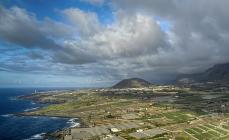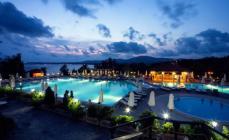*** This story is a fragment of a great story about a trip to northern Spain: " The Spanish North - From Bilbao to Gijon: Unusual Spain". It is clear that a passage taken from the general context by definition loses a lot, so it’s best to read the whole story - if you want to find it, it’s very easy!
0 0
I arrived in Gijon in the evening, when the setting sun gilded the buildings of the old city, built of yellow stone:

0 0

0 0

0 0

0 0

0 0

0 0

0 0
The main symbol of Gijon is the famous Pelayo, the image of which can be found here even on garbage containers:

0 0

0 0

0 0
Pelayo - visigoth kingfirst ruler Kingdom of Asturiasand therefore, if you simplify the situation and do not get into the jungle (in this story I do not want to do this) of all centuries-old historical intricacies - the first king of Spain, since Asturias, having existed under this name for about two centuries, became known as the Kingdom of Leon, which subsequently entered in Castile, well, namely Castile, no matter what the Aragonese say, was the core of the formation of modern Spain.
It is believed that it was from Pelayo that the Spanish reconquista "pushed off", which lasted for almost 8 centuries. It was under his command in 718 (according to some sources - in the 722nd) that the first victory was won over the Muslims who captured the Pyrenees a few years ago, which went down in history as Battle of Covadong. From a military point of view, she did not decide anything, because she had no influence on the alignment of the opposing forces at that moment, but her psychological significance was difficult to overestimate: according to G. Morton "The victory was the beginning of the Reconquista and led to the birth of the first of the Christian kingdoms - the kingdom of Asturias". Like most people like this, this event instantly grew with symbols and legends. Over time, Kovadonga became a place of worship and pilgrimage. In the cave, where Pelayo is believed to have taken refuge during the battle, now there is a small chapel with the image of Our Lady of Kovadong, declared by the patroness of Asturias And the cross that Pelayo allegedly saw before the battle, called Cross victory (Cruz de la Victoria), still adorns the coat of arms and flag of the modern Principality of Asturias:

0 0
A lot of big words have been written regarding this victory, but, speaking of it, I would like to refrain from excessive pathos. In the end, we must not forget that those who recaptured the Iberian lands only came here 200 years ago as invaders ...
However, no matter how great and revered here (I remind you that Gijon is the largest city in Asturias in terms of population, although Oviedo is its capital), Senor Pelayo, I'm not sure that he holds an unconditional 1st place among local symbols. Because in Gijon he has another very strong competitor, more precisely a competitor, because in Spain this word refers to the female gender: La sidra, or simply put, just cider.
Cider - low-alcohol apple (from 3 to 8 degrees) drink - has long been produced and drunk in many countries: in France, England, Belgium, Ireland, Germany. I don’t know how it is, but in Asturias, and it is in Gijon (from the cities that I visited) that cider is a cult drink. Honestly, I thought that despite all its historicity and symbolism, the attitude of local residents to cider is relatively calm: well, yes, he is, but there are no problems with him, yes, you can find him in every bar, yes, he’s still have a drink. And, perhaps (as I thought), cider has become more a tourist attraction than a part of the local lifestyle.
But no, no, and again no! I could not even imagine the scale of local cider nutrition! In the evening, on the tables at each cafe and bar, there were a huge number of people and EVERYONE drank cider! :) Of course, if you wanted, you could probably find a couple of renegades and opportunists, bashfully, hiding in a corner, sipping beer or wine, but in any case, they were completely lost in the masses drinking a yellow drink from green bottles. Evening Gijon lived as a cider and only a cider - and no Pelayo was able to compete with him in popularity. It looked something like this:

0 0
And this is still far from the most crowded ciderrea, as you can easily guess, institutions specializing in cider are called here. Now I regret that I didn’t take any more similar photos in different places - I could get a beautiful and vivid photoshoot “Cider in Gijón” ... For some reason I paid much more attention to signs:

0 0

0 0
The last photo is not indicative in terms of “humanity” - this is already a slightly different part of the city where people come to establishments not so much to drink and have fun, but how to calmly chat.
Gijon, by the way, turned out to be the only city (again of those where I was) where you could try cider just by asking for a glass (in other places it was sold only in bottles). What I did, having paid 1 euro and having at the same time a free pinchos with choriso from the tray exhibited on the bar counter. My opinion about cider turned out to be fairly even: on the one hand, I can’t say that I didn’t like it - and later I ordered it several more times for lunch. On the other hand, he is unlikely to be a dream for me, and if I never visit the “cider” regions again, I won’t be particularly upset about this. By the way, about the same attitude towards him, apparently, exists in Cantabria: when in Castro Urdiales I asked the bartender why they didn’t offer cider, he shrugged indifferently and said: “No, everyone just knows that he is everywhere, and if anyone wants to drink something cheaper, he orders cider. "
The process of pouring cider from bottle to glass deserves a special discussion (they are also special: large, wide, slightly conical. In Spain they are called culín - I don’t know, however, how ubiquitous). The waiter or bartender raises one hand with the bottle high up, drops the glass in the other hand as low as possible and begins the mystical process of “pouring”, which in Spanish corresponds to the verb escanciar, which simply means “pouring wine”. It looks something like this:

0 0
Sometimes the word "echar" or "tirar" is used for this situation, which translates more interestingly: throwing, throwing, dropping. Traditionally, it is believed that cider should be drunk while the foam is kept in the glass that forms during the “throwing” spill, and what remains after it disappears should simply be poured. In ancient times, this was done right on the floor, later in some institutions they began to install special gutters, where numerous cider remains merged. I read that with such foaming, cider is enriched with carbon dioxide from the air, which somehow affects its taste in a special way. I can’t say anything about this: I drank cider and foamed, and when the foam was already gone, I honestly didn’t feel the difference in taste.
With such popular popularity, the appearance of the “cider monument” on the promenade of Gijon is not at all surprising. More surprising is the fact that, judging by the pictures from Google’s cameras, he appeared only recently:

0 0

0 0

0 0
Gijon in its historical part (frankly, it's still difficult to call it an old city) is a very colorful and vibrant city - in the literal sense of these words, and a walk along it brought a lot of positive emotions.

0 0

0 0

0 0

0 0

0 0

0 0
Traditional for any Spanish city Main Square Plaza mayor in the traditional arcade style and on it, of course, unchanged ayuntamiento:

0 0

0 0
The most recognizable building of Gijon, we can safely say - its symbol is Palace of the Revillahihedo (Palacio de Revillagigedo), built at the very beginning of the 18th century.

0 0
It is not surprising that the palace resembles a fortress: during its construction, the medieval fortress tower of the 15th century was used (it is on the right, if you look at the facade of the building). But the left one was already built in its image and likeness for the general symmetry of the building. It is curious that a large coat of arms in the upper part of the facade appeared at the palace quite recently - in 2004 after a careful study of historical documents and photographs of the 19th century.
The Reviliahehedo Palace turned out to be one of the most beautiful and authentic structures that I had seen in northern Spain!
Fifteen years after the construction of the palace, a church was consecrated to his left, consecrated in honor of John the Baptist (San Juan Bautista), a small church that received the status of a colleague. Its square tower can be seen in previous photographs.
Another “brand” of Gijon, of course, significantly inferior in popularity to Pelayo and cider (or cider and Pelayo) is a person Gaspard Melchor de Jovellianos - Spanish writer and public figure of the time of the artist Goya and Prime Minister Manuel Godoy, known as the “Prince of Peace." Those who read the book L. Feuchtwanger “Goya, or the Hard Way of Knowledge,” probably remember the ups and downs of the relationship between these characters. A street, a theater, and a faculty of a local university are named in his honor in Gijon; the Hovelanos Institute is located here and, of course, the house museum where he was born.
Next to the preserved (relatively, of course) Roman baths, a monument to the emperor Octavian Augustusduring the reign of which after the conquest of Cantabria and Asturias (which went down in history under the name Cantabrian Wars) the entire Iberian Peninsula finally fell under the rule of the Roman Empire. And after the administrative reform of Augustus, the "north" became part of the province of Tarracon Spain.

0 0
By the way, it was in these places that the Romans "borrowed" many symbols associated with the Moon and the Sun, in particular, the standard with the so-called Cantabrian Cross (Lábaro cántabro), which was then used for another 300 years.

0 0
What church fence can be decorated with keys? Of course, the chief "paradise" administrator - apostle Peter !

0 0
And the church itself - here it is, it has been seen more than once in previous photos:

0 0
Another small medieval ensemble of the 17th century: chapel of St. Lawrence and tower of Hove Evia (Jove-Hevia). Both buildings were part of the family's family house with the aforementioned double surname:

0 0
In general, the historical part of Gijon is very small, but some ... very charming, or something - I did not regret at all that I came here.

0 0
Modern Gijon - It is mainly a city of 19-20 centuries, sometimes reminiscent of Bilbao. And interesting, in my opinion, is much less.

0 0

0 0

0 0
Church of St. Joseph (San José):

0 0
Neo-Gothic (early 20th century) church of St. Lawrence:

They speak only in excellent tones. It is the largest, oldest and greenest municipality in the Principality.
Gijon is located on the coast of the Bay of Biscay on an area of \u200b\u200balmost 200 square kilometers at 600 meters above sea level on the site of a former fishing village founded by the Celts in the 5th century BC.
Today it is a modern port city with a population approaching 300 thousand people. One of the most successful metropolitan areas of Northern Spain with a well-developed infrastructure, it is famous for its vibrant nightlife and crazy fiesta on weekends.



Weather in Gijon

This activity is facilitated by a mild Atlantic climate. It is never so hot here as in the rest of the Iberian Peninsula. In summer, air temperature rarely rises above 28 degrees, and in winter it does not fall below plus 5. True, the weather in Gijon is often rainy. The swimming season lasts from June to August.
In the remaining months, the ocean is cool. The water temperature in Gijon ranges from 12 to 15 degrees, but this does not prevent surf lovers from conducting their workouts.



Beaches of Gijon

Although Gijon is not the most popular beach resort, there is a great opportunity to spend time on the coast. The best beaches of Gijon are Arbeyal, Poniente and, of course, San Lorenzo. Stretching almost 3.5 kilometers along the sea, San Lorenzo is more suitable for extreme sports.
The water area of \u200b\u200bthe beach is characterized by strong currents and sharp drops in depth. It is better to go to the Poniente beach with sand brought from the Sahara to lovers of noisy entertainment. It is traditionally celebrated the feast of San Juan, burn bonfires all night and walk thousands of tourists, the cider festival is held. For a relaxing holiday, you can not find anything better than Arbeyal. By the way, all the beaches of Gijon are given the highest distinction – Blue flag




Port of Gijon El Musel – one of the largest in Spain. Its first dock was built at the end of the 15th century. Two centuries later, Gijon gained the right to trade with the Spanish colonies in America. And at the end of the 19th century, coal was unloaded for the first time in Spain in the port of Gijon. Today, about 3 thousand vessels call at the port of Gijon annually. And the turnover of its cargo transportation exceeds 17 million tons. Visit El Musel and cruise ships of any displacement.



Sights of Gijon

It is considered the largest building in Spain. The campus area is 11 hectares. And the height of the central tower is 130 meters. This is a quarter higher than the famous London Big Ben. The university was opened in 1946 to give higher education to the children of workers who died in coal mines. Today it houses the Center for Arts and Industrial Creativity, one of the faculties of the University of Oviedo, the Graduate School of Performing Arts and the Conservatory.



And at the university bell tower there is an observation deck with a magnificent view of the city and its surroundings. It is from here that the most spectacular photos of Gijon are obtained.
One of the most picturesque places is Isabel Park in Gijon, named after Queen Isabella I of Castile, or Isabella the Catholic. It was defeated in 1941 in a swampy area by landscape architect Ramon Ortiz.
Today, 15 hectares of the park’s area is occupied by attractions, flower beds, sculptures and a large pond, in which swans, geese and ducks nest, and peacocks are importantly walking along its shores.
For thrills, it's best to head to the Plaza de toros de El Bibio in Gijon. This is valid bullring . It was built in 1888 and can accommodate almost 10 thousand spectators!The main events take place here in August, when the city celebrates the feast of its patroness Madonna of Begony. In 1992, the El Bibio Arena was declared a monument of history and architecture.




Recently, the city of Gijon has attracted more and more tourists not only with the sights of Gijon, but also with advantageous offers for rental housing.
Gijon is the largest city of Asturias, spread out on the green hills by the sea. The old part of the city covers the peninsula, the upper point of which is crowned with the modern abstract composition "Praise the horizon." On cobblestone streets with colorful houses, there are restaurants and bars selling famous local cider, and arches lead to the stylish Plaza Mayor. Underground are the ruins of the Roman baths “Campo Valdes”, those interested in history can also visit the archaeological park “Campa de Torres”.
On both sides of the peninsula, along the marinas, the oceanarium and the spa resort of Talasoponiente, passes the beach of Poniente. The small beach of Playa del Arbeyal is located next to the port, and along the promenade of the popular San Lorenzo beach you can stroll to the church of San Pedro.
In Gijon you can go diving, watch dolphins, and for golf lovers in the green zone of the city there are 2 playing fields. The Atlantic Botanical Gardens - the first in northern Spain - are set across from the impressive campus of the Gijón University of Workers. Isabella Katolicki's landscape park is located near the El Bibio bullring, and across the river is the Gijon Exhibition Center and the Museum of Asturias.
The house-museum of Melchor de Hoveljanos, the greatest native of the city, is also open to visitors, after whom an elegant theater with a view of the Paseo de Begonia park is named.
Among the options for accommodation in Gijon, offered on the site are luxury beach hotels, guest houses near the station, and old mini-hotels.
It is located 30 km from Alicante, best known for the production of Spanish nougat - Turron, but also charming in its authenticity - you will forget that you are a stone's throw from the popular international resort.
The information below is provided by the Gijon tourist center (already translated), the style has been preserved original (minimal correction), photo - facebook Visitor Center Pages.
Turron Cradle
Gijon - cute, historical, bright
The history of Gijona dates back to the 13th century, to the timesdynasty of Moorish almohad, although within its limits there are archaeological finds from the Bronze Age. The name comes from the Latin "Saxum ", Which means rock or stone. In terms of territory, the city takes 5th place in the province of Alicante. About a third of the territory is covered by forest.
Star the second part of the city arose at the end of the 12th century, protected by a castle and a mountain "Penya migjorn ", Also known to locals as"Forat de la penya "(" A hole in the stone "). From the top it offers stunning views of the mountains and surrounding plains, extending down to the Mediterranean Sea. Until the 17th century, Gijon was surrounded by a wall.
Gijon is located at an altitude of 453 meters above sea level and 25 kilometers from Alicante in the direction of "L ’Alacanti ", Geography here is defined by mountains, in most cases by a chain of mountains"Carasqueta "- a natural connection between the cities of Alicante and Alcoy. The landscape is dominated by Spanish oak and fragrant plants, whose aroma spreads on the terraces where almond, olive and carob trees are grown.
A delightful place for new discoveries
Monuments of architecture:
Franciscan Monastery
Carreró de L ’Aula (School Alley)
Hermitage of Saint Sebastyana
Ravala Bakery
Mylovar House
Torre Blai (Bly Tower)
Church of St. Mary
Archpriest's Church
City hall
Casino
F. Apricot Primitivo Rovira
Workers Club
Family House Monerris Planelles
Family house Rovira
Family house Aracil
Other interesting places
Cultural Center
Cinema Dalt
Day nursery of Christ
Wide horizons, natural places.
Hiking Gijon - Vivens - Gijon Hiking - 16.5 kilometers
The route begins in the park "Barrac de la font "And continues towards"Al é cua ". He rises to "Llibreria "(Mountain education" Library ") and"El salt del moro "(The Moors Falls are now dry) and from there to"Costera d ’Ibi" (Ibi Mountain Range ) up to the place for picnics and relaxation "Font de Vivens ”(Source Vivens ) Then the path goes to "AltdelaMartina "(at the top of Martina ) and then descends along "BarrancodeCastalla »(Castalla Gorge ) to the intersection with the route that leads us back to Gijon.
Hiking Gijón - Peña Migjorn - Gijón route - 15 kilometers
Starting at the parkBarracdela font ", The path goes around the western side of the castle and rushes to the farmGacimal and housework pineta . Then it continues to the west, passing through the ravine "Cova dels corrals "And returns back to the starting point via"Segona Carena. "
Gijón - Pou del Surdo - Gijón Hiking - 11 kilometers
The route starts at the same place as the previous two. Then he crosses the city towards the Hermitage of St. Anthony and runs along the old road from Gijona to Alcoy, then along the valley “Bugaia "Rising to"Pou del Surdo "and the hotel" Pou de la Neu ". Passing by a television antenna, the road returns back to the previous route.
Outdoor activities
The countryside around the city offers a huge range of outdoor activities and sporting adventures, such as hiking, climbing, cycling and so on, and is an ideal venue for sporting events.
Natural spaces and parks
For those who love walking, there are three marked routes, a network of parks and beautiful natural spaces suitable for pleasant walks.
"Els Plantades "Is an urban nature reserve, crossed by mountains, with valleys of great ecological significance and natural beauty.
Other green recreation areas in the city that are also worth a visit:
St. Anthony Park
Park El Cuarnero
Park Barrac de la Font
El Salt (waterfall)
River trailCosc ó
Park Les Piletes
La Font der Moratell (source Moratell)
Mountains more than 1000 meters high and valleys covered with Mediterranean flora
Homeland ice cream
It is said that in Gijon, ice cream production began to flourish as a craft in the snow. Snow was stored in special pits and in the summer, turned into ice, transported and sold. By tradition, many families in Gijon produce ice cream, "horchatas »And cold drinks (glanizados).
When summer comes, families move to other cities in Spain in order to produce their product in accordance with the traditions, and the Xixona ice cream parlor chain is distributed throughout Spain.
"Snow Springs"
These are constructions built to save snow. The best preserved specimen near Xihony - "PoudelSurdo ". It is located on the mountain "Carrasqueta "At an altitude of 1100 meters. From this place opens a huge number of panoramic views of the area, full of natural contrasts, from the tops of the mountains down to the sea. Near the source, or cave, is a small suburban hotel - "Pou de la neu ”, Which was built on the site of the original home of workers who watched the snow.
Rich cooking
Turron is a dessert of Arab origin, which is made from sugar, honey and almonds. He quickly spread and won love all over the world. Turron is a typical treat during Christmas, however it is consumed throughout the whole year and in various ways.
Gijona is synonymous with Turron. However, in the gastronomy of the city there is a wide variety of other dishes, the roots of which also lie in the area. Among these traditional recipes can be distinguished "giraboix "," llegum "And rice with a rabbit.
Gijon confectionery is rich in juicy pieces that are made by hand, traditionally in ovens. You cannot missles iguales "Made from almonds, flour and cinnamon,"les doblades "Made from toasted almonds, sugar, butter and anise. You should also try "les tortades "Made from sugar, almonds and cinnamon.
Thanks of its main economic activity, Gijona has become home to the Governing Council for the Protection of the Trademark of the Present Turron of Gijona and Alicante (Regulatory Council of the Protected Designation of Origin Jijona and Alicante Turr ó n ), as well as for the National Association of Traditional Ice Cream Producers, as well as sellers of ice cream and orchits (National Association of Traditional Ice - Cream Makers, Ice - Cream and Horchata Sellers).
Turron Trail
Throughout the year, guests can find out about variousthe processes used in the production of turron, and the features of the ingredients used. They can also enjoy the opportunity to try and buy turron and other sweet treats such as marzipan, “polvorones "and so on.
Museum of Turron.
In the photo below - almonds, the basis of the production of turron.
Festivals, music and fun
Moors and Christians Festival
The main festival of Gijona, the feast of St. Bartholomew, whose history goes back over 200 years, is one of the oldest in the Valencian community. The festival is held in late August for 3 very busy days, when the whole city takes part in the celebration and fun. The historical battles between the Moors and Christians are recalled and presented with music, gunpowder, eye-catching costumes and parades.
The festival begins on July 24, on Signal Day (la Senyal ), an official event in which all groups of the festival take part. Every Saturday closer to the main festival,los sopares (small dinners / communions) are celebrated with informal parades on the streets of Gijón. Local music, instrument sounds and traditional dances are featured here.
Winter festival
This festival is celebrated on the third Saturday of February. The festival appeared so that families who spent the summer outside Gijón producing and selling ice cream in other cities throughout Spain, also had the opportunity to spend the holiday together. One of the most outstanding and colorful features of the festival is the flower market, during which all participants of the holiday dress in typical costumes of the places where their ice cream shops are located.
Traditions saturated with history
The Christmas Market revives the Gijona tradition, forgotten more than 200 years ago. In early December, thousands of tourists come to enjoy the open-air market, where they can purchase Christmas shopping and choose from the abundance of turron, marzipan, "polovorones »And a long list of delicacies that no table can do without on these holidays.
Another tradition that has stood the test of timeit covers both holidays at once - Christmas and New Year. These days the streets are filled with magic and light from the fire "aixames ", A kind of reed torch that hangs around while children beg for their Christmas presents.
Tourists who want to learn the “cradle of Turron” better can not miss the exciting procession of “Kings of the East” (Three Wise Men), nor “Porrates "(Traditional holiday) of St. Sebastian, nor"Candelaria "(The triumph of the purification of the Virgin Mary). The first holiday is celebrated in the second half of January, while “Candelaria »Takes place on the first weekend of February.
Today Gijon is part of the constellation of the largest cities on the Cantabrian coast. The beautiful curve of the coastline allows you to admire the unique picture created by rocky cliffs and huge boulders, between which comfortable bays with cozy beaches are sheltered. Jagged steep banks are the main attraction of the area in which Gijon is located.
The very geographical location of the city of Gijon contributes to the development of tourism. Just half an hour away on an amazing highway separate it from Ranon Airport. The central part of Gijón looks like a huge amphitheater. A couple of steps from the center of Gijón is an amazing beach with beautiful sand San Lorenzo. For those who do not want to relax on the central beach, the beaches of La Cagonera y La Nora, Serin, Penarrubia, El Rinconin, restored by El Arbeyal and Poniente, as well as small beaches hidden in the rocks offer their services.
However, the city offers not only the opportunity to sunbathe perfectly. Here is a beautiful bagpipes museum, an art center in the Palace of the Revillahihedo, Barjola (a museum of contemporary art). An unforgettable experience will be made by the pedestrian street designated for trade, Corrida. Copyright www.site
The city has an interesting Railway Museum, it was opened in one of the most beautiful historical buildings. It was built in 1874 and was previously a railway station, and several old railway tracks have been preserved next to it. The opening of the museum took place relatively recently, in 1998, the basis of its exposition is 140 antique cars, locomotives and rail trains. In total, the museum has collected about a thousand exhibits, one way or another connected with the history of the development of the railway.
The local aquarium introduces the diversity of the inhabitants of the underwater world to Gijon's guests; its opening took place in 2006. The aquarium is a major training center, in addition to the aquarium itself, there are several training rooms and museums within its walls. The center managed to recreate 60 unique aquatic ecosystems; it acquaints visitors with the characteristics of the inhabitants of various rivers and seas of the world. The center regularly holds interesting informative events, which will be interesting to visit not only for children but also for adults.
The city has the only botanical garden in Northern Spain, it was founded in 2003. Today, the garden covers an area of \u200b\u200babout 16 hectares; it is accessible for visiting all year round. Thanks to the presence of special indoor pavilions, visitors to the garden can even admire the variety of rare plants and flowers even in winter, and also take part in various recreational activities. The Botanical Garden regularly holds concerts, thematic conferences and various master classes.
On the territory of the city you can see several unique antique attractions, the ruins of ancient Roman baths are preserved here. The ancient complex managed to survive in an amazing way after more than 1800 years, today visitors to the term can admire the skillful old mosaics, and also see the heating system developed by the ancient engineers.






